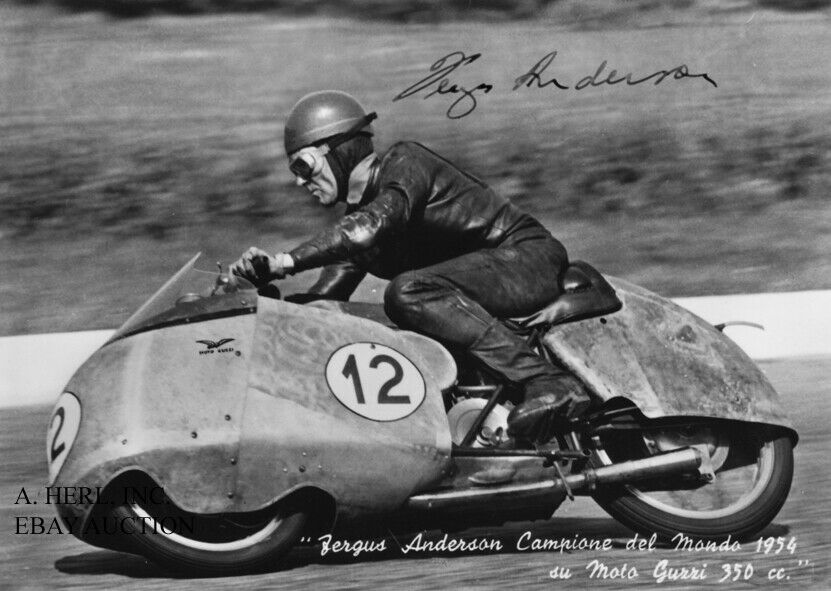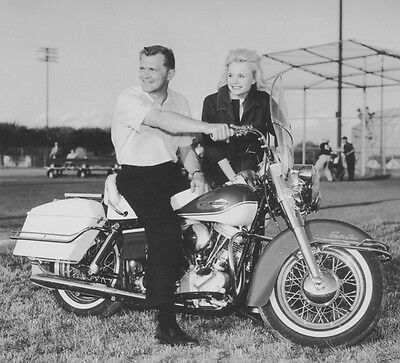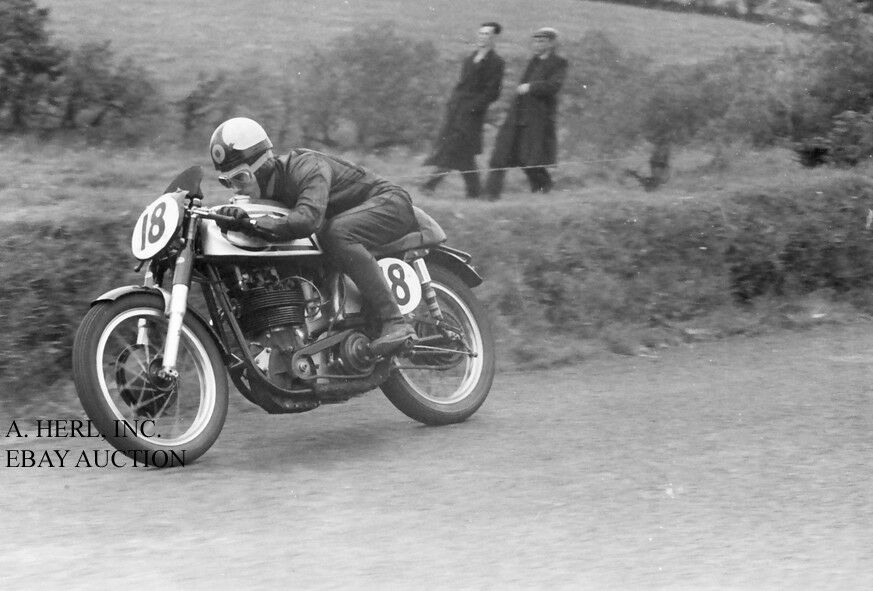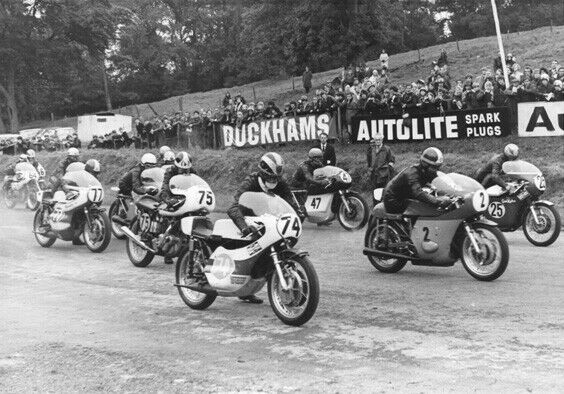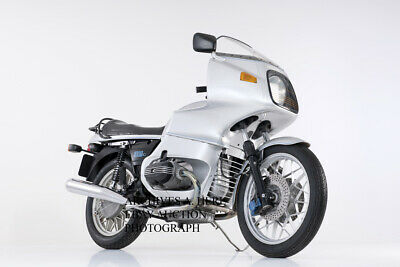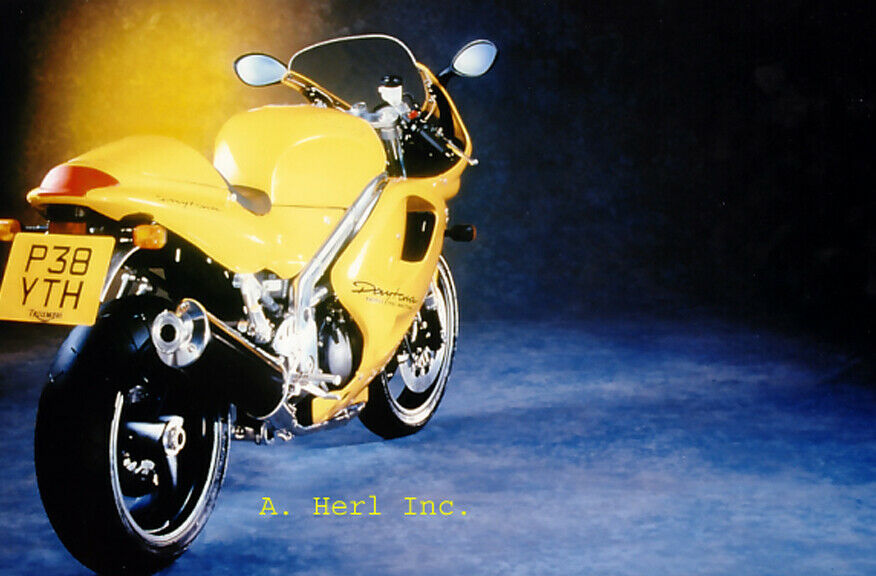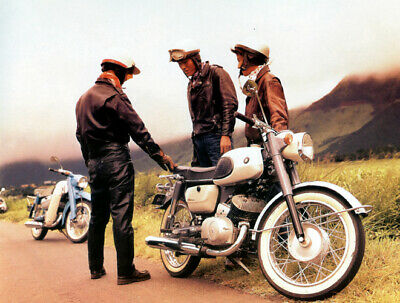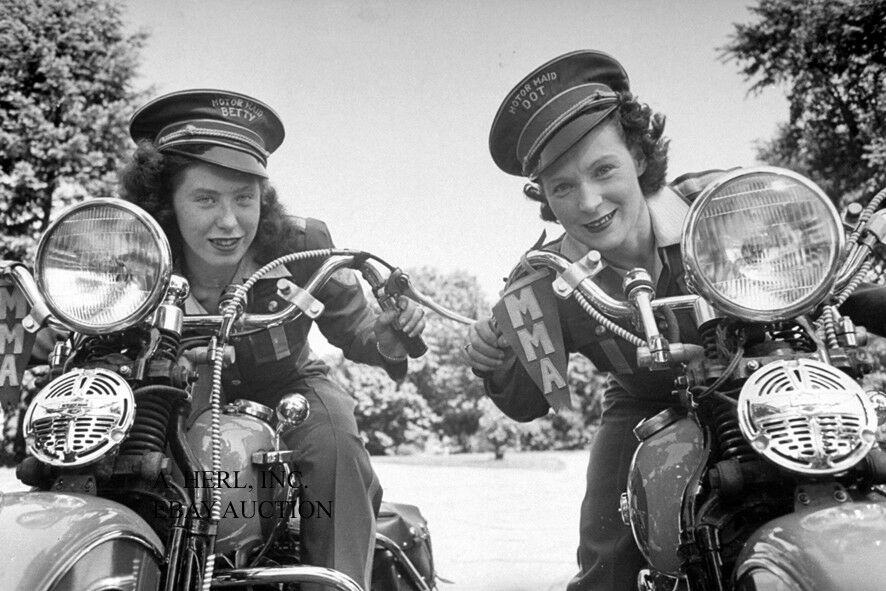-40%
Norton 750 Commando & Peter Williams – 1969 Thruxton 500 miles race - photograph
$ 5.14
- Description
- Size Guide
Description
Up for auction is a nice and rare photo of the greatPeter Williams
on his
750cc Norton Commando long distance racer
; photographed during the 1969
Thruxton
500
miles
race which was ridden on
May 11, 1969
.
This machine was one of the predecessors of the later JPN racing Nortons that were campaigned by, amongst others, Williams, Read and Cooper.
The
Norton Commando
was the last twin piston-engined motorcycle produced by the Norton Motorcycle company. Their last production bikes used a twin-rotor Wankel engine. During the ten years it was in production it was popular all over the world. In the
United Kingdom
it won the MCN "Machine of the Year" competition for five successive years from 1968-1972. The origins of the Norton Commando can be traced back to the late 1940s when the 497 cc Norton Model 7 Twin, designed by Bert Hopwood and initially an export only model. The twin cylinder design evolved into the 650 cc Norton Dominator and 750 cc Norton Atlas before being launched as the 750 cc Commando in 1967. The revolutionary part of the Commando, compared to earlier Norton models, was the frame developed by former Rolls Royce engineer Dr. Stefan Bauer. He believed the classic Norton Featherbed frame design went against all engineering principles, so Bauer designed his frame around a single 2.25-inch (
57 mm
) top tube. He tried to free the Commando from classic twin vibration problems, which had severely increased as the volume of the basic engine design expanded from the 500 cc of Edward Turner's 1938 Triumph Speed Twin. Bauer, with Norton Villiers Chief Engineer Bernard Hooper and assistant Bob Trigg, decided that the engine, gearbox and swing-arm assembly were to be bolted together and isolated from the frame by special rubber mountings. This eliminated the extreme vibration problems that were apparent in other models in the range, as it effectively separated the driver from the engine. Named the Isolastic anti-vibration system, the system's patent document listed Hooper as the lead inventor. Although the Isolastic system did reduce vibration, maintaining the required free play in the engine mountings at the correct level was crucial to its success. Too little play brought the vibration back; too much, and the result was "interesting" handling. The Norton Commando was introduced in 1967 at the Earls Court Show. The first production machines completed in April 1968 had bending frame problems, removed with the introduction of a new frame in January 1969. The original model, called the 'Fastback' was joined by the production racer 'S Type' which had a high level left-side exhaust and a 2.5 gallon petrol tank. Production of the machine was initially complex and located across different parts of
England
, with the engines produced in
Wolverhampton
, frames in
Manchester
, while components and final assembly was at Burrage Grove, Plumstead. In late 1968 Plumstead works was subject to a Greater London Council compulsory purchase order, and closed in July 1969. With assistance of a Government subsidy, the assembly line was moved to
North Way
,
Andover
; with the Test Department in an aircraft hangar on Thruxton Airfield. Frame manufacturing was transferred to
Wolverhampton
, where a second production line produced about 80 complete machines each week. Components and complete engines and gearboxes were also shipped overnight, from
Wolverhampton
to the
Andover
assembly line. The production racer, featuring an OHV tuned engine, front disk brake and was finished in bright yellow - known as the 'Yellow Peril'. In March to June 1970 the updated S called the 'Roadster' had the 750 cc OHV engine, low-level exhaust, upward angled silencers with reverse cones. September 1970 saw the introduction of the classic 'Fastback Mk2', which had alloy levers with modified stands and chain guards. The ‘Street Scrambler’ and the ‘Hi Rider’ were launched in May 1971, with the ‘
Fastback
Long
Range
’ with increased petrol tank capacity from July 1971. The ‘Combat’ engine was introduced in January 1972 saw the appearance of the ‘Mk4 Fastback’, updated ‘Roadster’ and the ‘750 Interstate’. The ‘Combat’ delivered 65 brake horsepower (48 kW) at 6500 rpm with a 10:1 compression ratio, but the stressed 750 cc twin proved extremely unreliable, with main bearing failures and broken pistons common. The 'Combat' engine combined with quality control problems gave the company a bad reputation, which was highly covered in the press. By the middle of 1972 BSA Triumph group were in serious financial trouble. The UK Government decided to bail the company out with a financial rescue package, providing it would agree to merge with Norton Villiers. Norton Villiers Triumph was duly formed and the new company got off to a shaky start. The last of the 750 series, the MkV was produced from November 1972 to mid-1973 as a 1973 model and featured improved crank bearings and the standard grind camshaft. Compression was reduced to 9.4:1. The police were showing a lot of interest in the Commando and so Neale Shilton was recruited from Triumph to produce a Commando to police specifications. The end result was the 'Interpol' machine, which sold well to police forces, both at home and abroad. The machine was powered by a 750 cc. O.H.V. engine and included panniers, top box, fairing, and had fittings for a radio and auxiliary equipment. In January 1973 the ‘Mk.5 Fastback’ was launched and the ‘
Long
Range
’ was discontinued, foreshadowing the first 850 cc machines launched in April 1973. The ‘Roadster’, ‘Hi Rider’ and the ‘Interstate’ all began to use a new 828 cc. engine, which had similar power to the 750 cc models but were less stressed. 1973 also saw the start of development on a new machine with a monocoque pressed steel frame, that also included a 500 cc twin, stepped piston engine called the 'Wulf'. However, as the Norton Villiers Triumph company was again in serious financial problems, development of the 'Wulf' was dropped in favour of the rotary Wankel type engine inherited from BSA. In late 1973 redundancy notices were issued at
Andover
, followed by a sit-in at the works. The Conservative Government withdrew the subsidy in early 1974, restored by the Labour party post the general election. NVT resultantly decided to concentrate production of the Commando at
Wolverhampton
and Small Heath, causing unrest at
Meriden
which resulted in a workers’ sit in and stopping production at Small Heath. By the end of 1974 NVT had lost over £3 million. However, the company still managed to produce new Commando models, with 1974 seeing the release of the Roadster based ‘JPN Replica’ and the ‘Mk.2a Interstate’. The 850 cc MK3 Commando was launched in March 1975 and for the first time was fitted with an "electric starter" - better described as electric "assister", as it would soon drain the battery. The range of models was reduced to just two machines, the ‘Mk.3 Interstate’ and the ‘Roadster’, both with a left side gear change, right foot brake and rear disk brake to comply with
United States
vehicle regulations. The specification remained unchanged until October 1977 when the last machines were made, although few 'Roadster's were made in the end due to the higher cash sales value of the Interstate. In 1975 the Industry Minister recalled a loan for £4 million and refused to renew the company’s export credits. The company then went into receivership and redundancies were announced for all of the staff at the various sites. At
Wolverhampton
an action committee was formed in an effort to continue production and develop the ‘Wulf’ engine - but the works was closed anyway. NVT was saved when the Small Heath/Meriden part of the company was subsidised by Industry Secretary Tony Benn as Industry Secretary, but this did not include Commando production. Ironically, the new company bought the gates from the now demolished
Wolverhampton
Tong
Castle
works, and erected at the works entrance in
Marston Road
, Small Heath.
Racing
Right from the beginning the Commando took part in racing events. After successes in 1969 by dealer entered machines like Paul Smart's second and Mick Andrew's 4th places in the Isle of Man TT Production class and a win in the Hutchinson 100 Production Class by Mick Andrew on the Gus Kuhn entered Commando and 4th by Peter Williams' Arter Bros machine, the company decided to produce a racing model - hence the developed S and "Yellow Peril" models. In partnership with John Player Special cigarettes from the early 1970s, Norton went factory racing. Early entries were based on the Commando, and in 1973 Peter Williams won the 1973 Formula 750 Isle of Man TT, with Mick Grant second. Racing continued until the collapse of Norton Villiers into BSA Triumph in 1973, and did not return until the Rotary engine Nortons of the 1980s. All in all, the Commando was a very successful model for Norton, names like the S Type, Roadster, Fastback Mk. 2 , Mk. 3 , Mk. 4 and Mk. 5 , but also the Street Scrambler , Hi Rider , Fastback 750 , Fastback Long Range and the Combat , Interstate , Mk. 2a Interstate , 828 Roadster ,
Mk.2 Hi Rider and off course the JPN Replica all became famous names in motorcycling history. In 1973 Peter Williams won the Formula 750 TT and Mick Grant came in second. It showed again the great racing capabilities of the Norton twin! In the early 1970’s, long distance racing was extremely popular in
Europe
. These events were responsible for the quick gaining popularity of the heavier sports motorcycle, like the Norton 750 Commando, the BSA Rocket 3 and BSA Goldstar the Triumph Trident, the Ducati 750 SS, the Moto Guzzi V7 Sport, The Moto Guzzi 850 Le Mans and the Benelli 650 Tornado, the BMW R 90 S Daytona and the Laverda SFC 750; but also the Japanese sports motorcycles like the Kawasaki 350, 500 and 750 triples, but also heavy four strokes like the Honda CB 750 Four. Riders that would make world fame, like Franco Uncini and Marco Lucchinelli, all participated in these races before they made the steps to the Grand Prix World Championship racing scene. In light of its "last of the classic British twins" tag, and the fact that many of the trade marks were disputed and patents expired, a number of new Norton companies began to emerge. These were based on production of new parts sourced from various manufacturers, and the legal battle over the Norton name between
Germany
(whose Norton was based on the Rotax 650 cc engine that powers the smaller BMW motorcycles),
Canada
and
North America
. Many used the Commando name for their lead model, or included the prospect of a Commando twin at a later date. However, the most interesting development for original Commando fans was the development of re-manufactured original motorcycles. These mainly came from Norvil in the
UK
and two companies in the
United States
, Colorado Norton Works and Kenny Dreer's Vintage Rebuilds based in
Portland
,
Oregon
. From 1995 onwards Vintage Rebuilds began restoring vintage British and Italian motorcycles, with Dreer showing a "new" Commando based Norton VR880 Sprint Special in 1999 with newly cast and manufactured parts, but using a bored out 880 cc twin engine with some modern developments. Kenny Dreer progressed from restoring and upgrading Norton Commandos to producing whole machines. He modernised the design and in the early 2000s went into series production of the Commando 961 SS, which combined traditional Norton cafe racer styling with new technology including carbon fibre wheels to reduce weight and a chro-moly tubular steel frame. Dreer was forced to suspend production in April 2006 following funding problems. After fifteen years of US ownership the Norton brand has now been secured by Stuart Garner, UK businessman and owner of Norton Racing Ltd. Garner plans to develop a new 15,000 sq ft (1,400 m2) Norton factory at Donington Park.
The original
Norton
company was formed by James Lansdowne Norton (Known as Pa) in
Birmingham
in
1898. In
1902 Norton began building motorcycles with French and Swiss engines. In
1907 a
Norton ridden by Rem Fowler won the twin-cylinder class in the first Isle of Man TT race, beginning a sporting tradition that went on until the 1960s – The Isle of Man Senior TT, the most prestigious of events, was won by Nortons ten times between the wars and then every year from 1947 to 1954. The first Norton engines were made in 1908, beginning a line of side-valve single cylinder engines which continued with few changes until the late 1950s. In 1913 the business declined, R.T. Shelley & Co., the main creditors, intervened and saved it. Norton Motors Ltd was formed shortly afterwards under joint directorship of James Norton and Bob Shelley. J.L. Norton died in 1925 aged only 56, but he saw his motorcycles win the Senior and sidecar TTs in 1924.
Designed by Walter Moore, the CamShaft One (CS1) engine appeared in 1927, based closely on the ES2 (pushrod) engine and using many of its parts. On his departure to NSU in 1930, an entirely new OHC engine was designed by Arthur Carroll, which was the basis for all later OHC and DOHC Norton singles. (
Moore
's move to NSU prompted staff to claim that NSU stood for "Norton Spares Used") That decade spawned the Norton racing legend. Of the nine Isle of Man Senior TTs (500 cc) between 1931 and 1939 Norton won seven. Up to 1934, Norton bought the excellent Sturmey Archer gearboxes and clutches. When Sturmey decided to discontinue production, Norton bought the design rights, and had them made by Burman, a manufacturer of proprietary gearboxes. Nortons also appealed to ordinary motorcyclists who enjoyed the reliability and performance offered by single-cylinder engines with separate gearboxes. The marque withdrew their teams from racing in 1938, but between 1937 and 1945 nearly one quarter (Over 100,000) of all British military motorcycles were Nortons, basically the WD
16H
(solo) and WD Big Four outfit (with driven sidecar wheel). After the War, Norton reverted to civilian motorcycle production, gradually increasing the range. A major addition in 1949 was the Dominator, also known as the Model
7, a
pushrod 500 cc twin cylinder machine designed by Bert Hopwood. Its chassis was derived from the ES2 single, with telescopic front and plunger rear suspension, and an updated version of the gearbox known as the 'horizontal' box. Post war, Norton struggled to reclaim its pre-WWII racing dominance, since the single cylinder machine was facing fierce competition from the multi-cylinder Italians, and AJS at home. In the 1949 Grand Prix motorcycle racing season, the first year of the world championship, Norton only made fifth place, and AJS won. That was before the Norton Featherbed frame appeared, developed for Norton by the McCandless brothers of
Belfast
in January, 1950, used in the legendary Manx Norton, and raced by riders including Geoff Duke, John Surtees and Derek Minter. Overnight the featherbed frame was the benchmark by which all other frames were judged. Nortons were winners again. Norton also experimented with engine placement, and discovered that moving the engine slightly up/down, forward/back, or even right/left, could deliver a "sweet spot" in terms of handling. In 1951 the Norton Dominator became available in export markets as the Model 88 with the Featherbed frame. Later, as production of this frame increased, it became a regular production model, and was made in variants for other models, including the ohv single cylinder machines. The racing successes were transferred to the street through Cafe racers, some of whom would use the feather bed frame with an engine from another manufacturer to make a hybrid machine with the best of both worlds. The most famous of these were Tritons - Triumph twin engines in a Norton feather-bed frame. Despite, or perhaps because of the racing successes, Norton was in financial difficulty. Reynolds could not make many of the highly desired featherbed frames, and customers lost interest in buying machines with the older frames. In 1953, Norton was sold to Associated Motorcycles (AMC), who also owned the brands AJS, Matchless, Francis-Barnett and James. The
Birmingham
factory was closed in 1962 and production was moved to AMC's Woolwich factory in south east
London
. Under AMC ownership, a much improved version of the Norton gearbox was developed, to be used on all the larger models within the corporation under the AJS, Matchless and Norton banners. Again, the major changes were for improved gear selection. In late
1955 a
600 cc Dominator 99 appeared. The 1946-1953 Long Stroke Manx Norton was 79.6 mm x
100 mm
, initially sohc, the dohc engine becoming available to favoured racers in 1949. The Short Stroke model (1953-1962) had bore and stroke of
86 mm
x 85.6 mm. It used a dry sump 499 cc single cylinder motor, with two valves operated by bevel drive, shaft driven twin overhead camshafts. Compression ratio was 11:1. It had an Amal GP carburettor, and a Lucas racing magneto. The 1962 500 cc Manx Nortons produced 47 bhp (35 kW) at 6500 rpm, weighed
142 kg
(
313 lb
), and had a top speed of
209 km/h
(
130 mph
).[6] The new price was £440. Manx Nortons also played a significant role in the development of post war car racing. At the end of 1950, the English national 500 cc regulations were adopted as the new Formula 3. The JAP Speedway engine had dominated the category initially but the Manx was capable of producing significantly more power and became the engine of choice. Many complete motorcycles were bought in order to strip the engine for 500 cc car racing, as Nortons would not sell separate engines. Manx rolling chassis were frequently resold, and equipped with Triumph engines. These motorcycles were known as Tritons. In
1960, a
new version of the featherbed frame was developed, with the upper frame rails bent inwards to reduce the width between the rider's knees for greater comfort. The move was also to accommodate the shorter rider, as the wide frame made it difficult to reach the ground. This frame was made in-house by AMC, and is known as the 'slimline' frame - the earlier frames then became known as the 'wideline'. The last Manx Nortons were sold in 1963. Even though Norton had pulled out of racing in 1954, the Manx had become the backbone of privateer racing, and even today are quite sought after. In January
1961 a
new Norton Manxman 650c was launched for the American market only. One year later a Norton 650SS appeared,for the
UK
market along with the Norton Atlas
750 in
1962. For the American market more power was desired. Featherbed frames were still used, but the increases to the vertical twins engine capacity had caused a vibration problem at 4500 rpm. A 500 cc vertical twin is smoother than a single cylinder, but if you enlarge the vertical twin's capacity, vibration increases. The 750 Norton Atlas proved too expensive, and costs could not be reduced. Financial problems gathered. There was an export bike primarily for use as a desert racer, sold up until 1969 as a Norton P11, AJS Model 33, and as a Matchless G15, which used the Norton Atlas engine in a modified Matchless G85CS scrambler frame, with Norton wheels and front forks. This bike was reputed to vibrate less than the featherbed frame model. AMC singles were also sold with Norton badging in this era. By the late 1960s competition from
Japan
and a rapidly declining home market had driven the whole British motorcycle industry into a precipitous decline. In 1966 AMC collapsed and was reformed as Norton-Villiers part of Manganese Bronze. The 750 Norton Atlas, was noted for its vibration. Rather than change engines, Norton decided to change the frame, and the isolastic-framed Norton Commando 750 was the result. In 1969 the Commando was introduced; its styling, innovative isolastic frame, and powerful engine made it an appealing package. The Commando easily outperformed Triumph and BSA, and was the most powerful and best-handling British motorcycle of its day. The "isolastic frame," derived from the Featherbed, made it much smoother than the Atlas. It used rubber bushings to isolate the engine and swingarm from the frame, forks, and rider. As the rubber bushings wore, however, the bike became prone to fishtailing in high-speed turns. The customer could choose between single and dual carburettors, and the bike came in several different styles: the standard street model, a pseudo-scrambler with upswept pipes, and the Interstate, packaged as a tourer. Electric start was introduced in 1974. Sales were respectable, but the company declined financially and went into liquidation in
1975. In
1976 a
Norton with a US-flag theme on the tank could be purchased for 76. The 'Combat' engine was released in January 1972, with a twin roller bearing crank, 10:1 compression and making 65 bhp (48.5 kW) at 6,500 rpm. Reliability immediately proved a problem. (Older engines had used one ball bearing main, and one roller bearing main.) This fragility did not show up well, especially when compared to the reliability of the Japanese bikes.
In 1972, the former giant of British motorcycle manufacturing BSA was also in trouble. It was given government help on the condition that it merged with Norton-Villiers, and in 1973 the new Norton-Villiers-Triumph (NVT) was formed. The Triumph Motorcycles name came from BSA's Triumph subsidiary. In April 1973 an 8.5:1 compression 828 cc "850" engine was released with German SuperBlend bearings, which made 51 bhp (38 kW) at 6,250 rpm however the stated power does not give a true picture of the engine performance because increased torque seemed to make up for the lower horsepower. In 1974, the outgoing government withdrew the subsidies, although the incoming government restored them after the election. Rationalisation of the factory sites to
Wolverhampton
and
Birmingham
(BSA's Small Heath site) only caused industrial disputes at Triumph's
Coventry
site; Triumph would go on as a workers cooperative alone. Despite mounting losses, 1974 saw the release of the ‘828 Roadster’, ‘Mark 2 Hi Rider’, ‘JPN Replica’ (John Player Norton) and ‘Mk.2a Interstate’. In 1975 this was down to just two models, the 'Mark 3 Interstate' and the 'Roadster', but then the Government asked for a repayment of its loan and refused export credits, further damaging the company's ability to sell abroad. Production of the two lone models still made was ended and supplies dwindled. In the 1980s, the company went through several incarnations – mainly because, both the name was popular, and now owned by several parties: in liquidation from NVT, the global rights were split between (at least) Norton UK,
Germany
,
America
and Rest of the World. The name was relaunched on an ambitious scale in
Lichfield
in 1988. The new models have succeeded on the race track – winning the Senior TT in 1992 – but they have moved rather more slowly in the commercial market. The British company had some success making the Wankel-engined Interpol 2 motorcycle for civilian and military police forces and the RAC. This led to a civilian model in 1987 called the Classic. Subsequent Norton Wankels were water-cooled. The Commander was launched in 1988 and was followed by the Spondon-framed F1. This model was a replica of Norton's RCW588 factory racing machines which won many races including the 1992 Isle of Man TT. The F1 was succeeded by the restyled and slightly less expensive F1 Sport. At this point the Department of Trade and Industry stepped in to investigate improprieties in the investment web of financier Philippe LeRoux and his associates. LeRoux resigned his position as Chief Executive. Norton is now a small entity dealing with the approximately 1000 Norton Rotary motorcycles. During the 1990s, Kenny Dreer of
Oregon
evolved from restoring and upgrading Commandos to producing whole machines. He modernised the design and in the early 2000s went into series production, but then suspended operations in April 2006. After fifteen years of US ownership the Norton brand has now been secured by Stuart Garner,
UK
businessman and owner of Norton Racing Ltd. Garner plans to develop a new 15000 sq foot Norton factory at
Donnington
Park
. In the
UK
a number of firms such as the remnant of the Shenstone Norton factory, Norvil, Unity Equipe and Norman White, a former team racer and mechanic, supply parts for various generations of Norton motorcycles.
It is a very nice
non period
photo that reflects the golden era of roadracing in a wonderful way. Therefore it is printed in a nice large format of approx. 8" x 11" (ca. 20 x
28 cm
). It makes it perfectly suitable for framing!
Check out our other Ebay auctions or contact us for more Norton and other motorcycle images
and use the shipping discount!
Shipping costs will only be $ 7.00 regardless of how many photos you buy. For 5 or more photos, shipping is free!
(Note: A. Herl, Inc. does not appear on photo, for ebay purposes only)
No copyright expressed or implied. Sold as collectable item only. We are clearing out our archives that we have gathered from various sources.
All items always sent well protected in PVC clear files
and board backed envelopes.
We have photographs that came from professional collections and/or were bought from the original photographer or press studio! They are all of professional and excellent quality.
After many decades of professionally collecting photographs and posters we are clearing out our archives. They make the perfect gift and are perfectly suited for framing. They will look gorgeous unframed and will be a true asset nicely framed with a border. They are a gorgeous and great asset in every home, workshop, workplace, restaurant, bar or club!
First come - first served. And you can always contact us for your requests. Please ask any questions before the auction ends.

